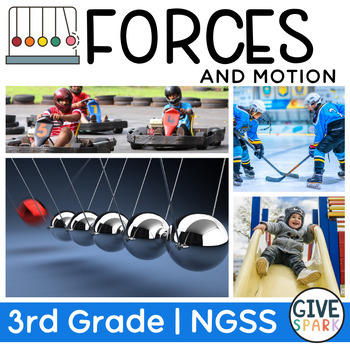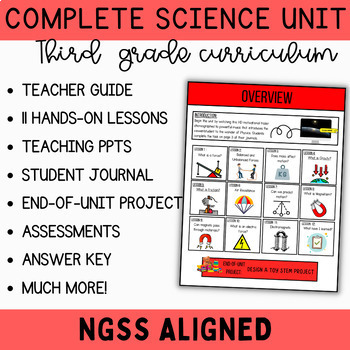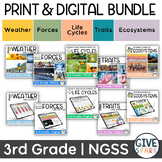3rd Grade NGSS Science Unit: Forces and Motion - Complete Printable Unit
- Zip
What educators are saying
Also included in
- 3rd Grade - NGSS Science Bundle - YEAR LONG Curriculum - FIVE UnitsWelcome to the ultimate science teaching solution for 3rd grade educators - the 3rd Grade Science Super Bundle. This all-inclusive package is specially designed to ignite curiosity, enhance understanding, and fuel the passion for sciPrice $69.75Original Price $79.75Save $10.00
- PRINT and DIGITAL - Forces and Motion - Third Grade Science Bundle - NGSSThis comprehensive bundle unit is specifically designed for third-grade students to learn about the topic of Forces and Motion.STANDARDS ALIGNMENT:The unit consists of 11 engaging lessons that incorporate hands-on activities. IPrice $22.50Original Price $28.95Save $6.45
- Third Grade NGSS: The Ultimate Teaching Bundle – Print & Digital!Get ready for an exciting science journey with this all-in-one bundle, perfect for third-grade teachers. This package includes FIVE highly engaging science units, all aligned with the NGSS standards. In this package, you will receiPrice $110.00Original Price $144.75Save $34.75
Description
Forces and Motion - Third Grade - NGSS Aligned- Complete Unit
This comprehensive science unit offers an immersive exploration of Forces and Motion through 11 dynamic lessons, complete with PowerPoint presentations, detailed lesson plans, and student journals. Culminating in a collaborative project aligned with NGSS Science and Engineering Practices, students get to apply their knowledge in an exciting, hands-on scientific endeavor.
--------------------APPROACH TO LEARNING---------------------
Unlock your students' natural curiosity and passion for science with this interactive and hands-on teaching unit. Designed to connect with their prior knowledge and provide immersive experiences, this unit offers lessons that guide students through complex scientific principles in an accessible way. Students will actively participate in hands-on experiments and activities that make learning exciting and memorable. This unit promotes independent learning and encourages students to reflect on their understanding, helping them build a solid foundation of knowledge in a fun and stimulating environment.
What's Covered?
- Lesson 1 - What is a force?
- Lesson 2 - Balanced and Unbalanced Forces
- Lesson 3 - Does mass affect motion?
- Lesson 4 - What is gravity?
- Lesson 5 - What is friction?
- Lesson 6 - Air Resistance
- Lesson 7 - Can we predict motion?
- Lesson 8 - What is magnetism?
- Lesson 9 - Can a magnetic field pass through any material?
- Lesson 10 - What is an electric force?
- Lesson 11 - Electromagnets
--------------------End of Unit Project---------------------
End of Unit Project: "Funlada Toy Designers"
Dive deep into the world of toys and uncover the science behind their movement! In this STEM-based project, students will dissect the mechanics of their favorite toys, exploring the principles of force and motion that bring them to life. But that's just the beginning. Using their newfound insights, teams will collaborate to conceive, design, and prototype a groundbreaking toy destined for the shelves of a renowned Toy Store. This project is an experiential approach to learning that allows students to apply their knowledge in a collaborative, meaningful, and FUN way!
--------------------WHAT'S INCLUDED?---------------------
- Engaging Lessons: This unit has 11 core lessons that are designed to connect with students' prior knowledge and guide them through complex scientific principles in an accessible way.
- Comprehensive Teaching Resources: For each unit, you'll receive teaching presentations, a detailed teacher's guide, an interactive student science journal, and more.
- End-of-Unit Project: Students use the engineering and design process to design their own toys.
- Reading Tasks and Comprehension Activities: A range of read-and-response activities are included to enhance reading comprehension skills and understanding of scientific concepts.
- Hands-on Labs - A range of engaging labs that invite children to explore and learn through genuine inquiry and discovery.
- Vocabulary Posters: Key vocabulary terms are reinforced with visually appealing posters to aid retention and understanding.
- Formative and Summative Assessments: Gauge your students' progress with various comprehension tasks, quizzes, and reflection/journal prompts.
- Answer Keys: Save time on marking with included answer keys or model answers.
This unit offers an all-encompassing resource, providing everything you need to deliver engaging and effective science lessons throughout the entire academic year.
For a detailed look at each unit, please download the individual preview.
Customer Support:
- Email me at givesparkco@gmail.com
- submit a help ticket
- ask a question on the Q& A tab
Thank you for stopping by!
Best regards,
Vicky x
If you would like to get updates on NEW and CURRENT resources...
►FOLLOW me on Teachers Pay Teachers!
TERMS OF USE - © Give Spark, Inc.™
This item is a paid digital download from my TpT store.As such, it is for use in one classroom only. This item is also bound by copyright laws. Redistributing, editing, selling, or posting this item (or any part thereof) on the Internet are all strictly prohibited without first gaining permission from the author. Violations are subject to the penalties of the Digital Millennium Copyright Act. Please contact me if you wish to be granted special permissions.








